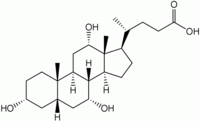Cholic acid
| Cholic acid | |
|---|---|
 | |
 | |
| IUPAC name (R)-4-((3R,5S,7R,8R,9S,10S,12S,13R,14S,17R)- 3,7,12-trihydroxy-10,13-dimethylhexadecahydro-1H- cyclopenta[a]phenanthren-17-yl)pentanoic acid | |
| Other names 3α,7α,12α-trihydroxy-5β-cholanoic acid | |
| Identifiers | |
| CAS number | 81-25-4 |
| PubChem | 221493 |
| ChemSpider | 192176 |
| UNII | G1JO7801AE |
| DrugBank | DB02659 |
| ChEBI | CHEBI:16359 |
| ChEMBL | CHEMBL205596 |
| ATC code | A05 |
| Jmol-3D images | {{#if:C[C@H](CCC(=O)O)[C@H]1CC[C@@H]2[C@@]1([C@H](C[C@H]3[C@H]2[C@@H](C[C@H]4[C@@]3(CC[C@H](C4)O)C)O)O)C|Image 1 |
| |
| |
| Properties | |
| Molecular formula | C24H40O5 |
| Molar mass | 408.57 g/mol |
| Melting point | 200-201 °C |
| Except where noted otherwise, data are given for materials in their standard state (at 25 °C (77 °F), 100 kPa) | |
| Infobox references | |
Cholic acid is a bile acid,[1] a white crystalline substance insoluble in water (soluble in alcohol and acetic acid), with a melting point of 200-201 °C. Salts of cholic acid are called cholates. Cholic acid, along with chenodeoxycholic acid, is one of two major bile acids produced by the liver where it is synthesized from cholesterol. Of the two major bile acids, cholate derivatives represent approximately eighty percent of all bile acids. These derivatives are made from cholyl-CoA, which exchanges its CoA with either glycine, or taurine, yielding glycocholic and taurocholic acid respectively.[2]
Cholic acid downregulates cholesterol-7-α-hydroxylase (rate-limiting step in bile acid synthesis), and cholesterol does the opposite. This is why chenodeoxycholic acid, and not cholic acid, can be used to treat gallstones (because decreasing bile acid synthesis would supersaturate the stones even more).[3][4]
Cholic acid and chenodeoxycholic acid are the most important human bile acids. Some other mammals synthesize predominantly deoxycholic acid.[5]

Interactive pathway map
Click on genes, proteins and metabolites below to link to respective articles. [§ 1]
- ↑ The interactive pathway map can be edited at WikiPathways: "Statin_Pathway_WP430".
References
- ↑ Colleen Smith; Lieberman, Michael; Marks, Dawn B.; Allan D. Marks (2007). Marks' essential medical biochemistry. Hagerstwon, MD: Lippincott Williams & Wilkins. ISBN 0-7817-9340-8.
- ↑ Chiang JY (October 2009). "Bile acids: regulation of synthesis". Journal of Lipid Research 50 (10): 1955–66. doi:10.1194/jlr.R900010-JLR200. PMC 2739756. PMID 19346330.
- ↑ Iser JH, Dowling H, Mok HY, Bell GD (August 1975). "Chenodeoxycholic acid treatment of gallstones. A follow-up report and analysis of factors influencing response to therapy". The New England Journal of Medicine 293 (8): 378–83. doi:10.1056/NEJM197508212930804. PMID 1152936.
- ↑ Alan F. Hofmann, Johnson L. Thistle, Peter D. Klein, Patricia A. Szczepanik, Paulina Y. S. Yu (1978). "Chenotherapy for Gallstone Dissolution, II. Induced Changes in Bile Composition and Gallstone Response". JAMA 239 (12): 1138–1144. doi:10.1001/jama.1978.03280390034017.
- ↑ Urich, Klaus (1994). Comparative animal biochemistry. Berlin: Springer-Verlag. ISBN 3-540-57420-4.
| |||||||||||||
